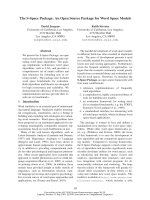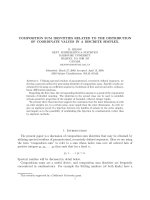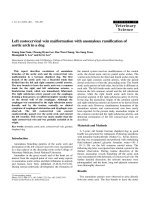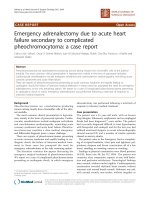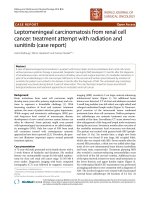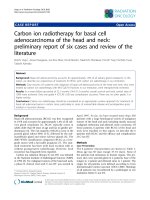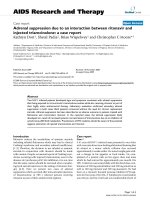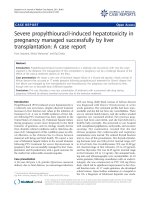Báo cáo khoa hoc:" Bouveret''''s syndrome as an unusual cause of gastric outlet obstruction: a case report" pptx
Bạn đang xem bản rút gọn của tài liệu. Xem và tải ngay bản đầy đủ của tài liệu tại đây (617.47 KB, 3 trang )
BioMed Central
Page 1 of 3
(page number not for citation purposes)
Journal of Medical Case Reports
Open Access
Case report
Bouveret's syndrome as an unusual cause of gastric outlet
obstruction: a case report
Deepak Joshi*
1
, Ali Vosough
1
, Tom M Raymond
2
, Chris Fox
1
and
Arun Dhiman
1
Address:
1
Department of Gastroenterology, William Harvey Hospital, Ashford, Kent, UK and
2
Department of Surgery, William Harvey Hospital,
Ashford, Kent, UK
Email: Deepak Joshi* - ; Ali Vosough - ; Tom M Raymond - ;
Chris Fox - ; Arun Dhiman -
* Corresponding author
Abstract
An 83 year old caucasian gentleman presented with vomiting and left sided abdominal pain. A
subsequent upper GI endoscopy demonstrated a large smooth mass impacted within the
duodenum. A cholecysto-duodenal fistula was discovered at laparotomy, with a large gallstone
impacted in the duodenum. A diagnosis of Bouveret's syndrome was made. The management of this
rare cause of gastric outlet obstruction is discussed.
Background
Gallstones, in the majority of patients remain asympto-
matic. The commonest clinical manifestation is biliary
colic. Gallstone ileus occurs when a stone enters the intes-
tinal tract via a cholecysto-enteric fistula. The authors
present a case of Bouveret's syndrome, a rare complication
of gallstone disease and rare cause of gastric outlet
obstruction.
Case presentation
An 83 year old gentleman was admitted with a one week
history of vomiting after eating and left-sided upper quad-
rant abdominal pain. There was no history of dysphagia
or weights loss. The patient had suffered a similar episode
the year previously which had resolved spontaneously.
Abdominal examination was unremarkable. No succes-
sion splash was evident. A full blood count, liver function
tests and urea and electrolytes were normal. No free air
under the right hemi-diaphragm was noted on a chest
radiograph. A plain abdominal film was negative for evi-
dence of aerobilia or gallstones. A naso-gastric tube was
inserted. The patient subsequently underwent an
oesophago-gastro-duodenoscopy (OGD) to exclude pos-
sible mechanical obstruction. At OGD, a mass was noted
beyond the pylorus (Figure 1). In the first part of the duo-
denum, the large smooth mass was seen occupying the
whole lumen with ulceration of the visible surrounding
mucosa (Figure 2). The mass was irretrievable endoscopi-
cally.
Computed tomography (CT) of the abdomen demon-
strated a large calcified mass in the first part of the duode-
num (Figure 3). The patient underwent an open
laparotomy where a cholecysto-duodenal fistula was
found with a large gallstone impacted in the duodenum.
No other synchronous gallstones were discovered. The
gallstone was irretrievable and therefore a gastro-jejunos-
tomy was performed. A diagnosis of Bouveret's syndrome
was made.
Published: 30 August 2007
Journal of Medical Case Reports 2007, 1:73 doi:10.1186/1752-1947-1-73
Received: 16 January 2007
Accepted: 30 August 2007
This article is available from: />© 2007 Joshi et al; licensee BioMed Central Ltd.
This is an Open Access article distributed under the terms of the Creative Commons Attribution License ( />),
which permits unrestricted use, distribution, and reproduction in any medium, provided the original work is properly cited.
Journal of Medical Case Reports 2007, 1:73 />Page 2 of 3
(page number not for citation purposes)
Post operatively the patient continued to produce large
gastric aspirates via a naso-gastric tube. A repeat OGD
demonstrated that both afferent and efferent loops were
patent. The large gallstone was noted once again but this
time in the second part of the duodenum. The patient
returned to theatre where this time the gallstone (Figure
4) was successfully milked into the distal jejunum and
removed via an enterotomy. The patient made an une-
ventful recovery.
Case discussion
Gallstone ileus is rare [1]. The majority of gallstones that
enter the GI tract via a cholecysto-enteric fistula are passed
spontaneously. Obstruction most commonly occurs in
the terminal ileum (90%) and less often in the duodenum
(3%) [2]. The differential diagnosis of gastric outlet
obstruction includes diverticulae, foreign bodies, fibrotic
ulcers and neoplasia Gastric outlet obstruction secondary
to an impacted gallstone in the pyloric region or duodenal
bulb is known as Bouveret's syndrome. More common in
elderly women, Bouveret's syndrome presents with a non
specific triad of epigastric pain, nausea and vomiting.
Abdominal and chest radiographs should be performed
looking for evidence of aerobilia, bowel obstruction and
ectopic gallstones. Abdominal CT should also be per-
Removed gallstoneFigure 4
Removed gallstone.
A large smooth mass in the first part of the duodenum with associated ulcerationFigure 2
A large smooth mass in the first part of the duodenum with
associated ulceration.
View at the pylorus, demonstrating a mass in the duodenal bulbFigure 1
View at the pylorus, demonstrating a mass in the duodenal
bulb.
Abdominal CT demonstrating a calcified mass in duodenumFigure 3
Abdominal CT demonstrating a calcified mass in duodenum.
Publish with BioMed Central and every
scientist can read your work free of charge
"BioMed Central will be the most significant development for
disseminating the results of biomedical research in our lifetime."
Sir Paul Nurse, Cancer Research UK
Your research papers will be:
available free of charge to the entire biomedical community
peer reviewed and published immediately upon acceptance
cited in PubMed and archived on PubMed Central
yours — you keep the copyright
Submit your manuscript here:
/>BioMedcentral
Journal of Medical Case Reports 2007, 1:73 />Page 3 of 3
(page number not for citation purposes)
formed. Typical findings on OGD include a dilated stom-
ach and a hard non-fleshy mass at the obstruction [3].
Treatment options include endoscopic and surgical man-
agement. Endoscopic removal should always be
attempted first, but lithotripsy and stone extraction is
rarely successful [4]. Intracorporeal endoscopic electrohy-
draulic lithotripsy has been used successfully in the treat-
ment of Bouveret's syndrome [5] Surgical options include
enterotomy and removal of the stones (enterolithotomy),
enterolithotomy plus cholecystectomy and repair of the
fistula, or gastric bypass surgery. The decision to use min-
imal invasive surgery versus laparotomy should be made
on an individual patient basis and operator experience.
Fistula repair is unnecessary due to spontaneous closure
especially if the cystic duct is patent and no residual stones
are present. Post operative mortality rates are high, and
may reflect the older subgroup of patients affected [6].
Conclusion
The authors present a case of Bouveret's syndrome in an
83 year old gentleman. The diagnosis should be consid-
ered in patients with symptoms of gastric outlet obstruc-
tion with or without a history of gallstones or aerobilia
and typical endoscopic findings of a dilated stomach and
a hard non-fleshy mass at the obstruction.
Competing interests
The author(s) declare that they have no competing inter-
ests.
Authors' contributions
DJ, AV and TR were involved in writing of the case report.
CF and AD were involved in the review and re-writing of
the case report. All five authors were involved in the
patient's care.
Acknowledgements
Written consent was obtained from the patient prior to submission.
References
1. Bhama JK, Ogren JW, Lee T, Fisher WE: Bouveret's syndrome.
Surgery 2002, 131:104-5.
2. Clavien PA, Richon J, Burgan S, Rohner A: Gallstone ileus. Br J Surg
1990, 77:737-42.
3. Capell MS, Davis M: Characterisation of Bouveret's syndrome:
a comprehensive review of 128 cases. Am J Gastro 2006,
101(9):2139-46.
4. Marchall J, Hayton S: Bouveret's syndrome. The American Journal
of Surgery 2004, 187:547-548.
5. Huebner ES, DuBois S, Lee SD, Saunders MD: Successful endo-
scopic treatment of Bouveret's syndrome with Intracorpor-
eal endoscopic electrohydraulic lithotripsy. Gastrointestinal
endoscopy 2007, 66(1):183-184.
6. Schweiger FJ, Shinder R: Duodenal obstruction by a gallstone
(Bouveret's syndrome) managed by endoscopic stone
extraction: a case report and review. Can J Gastroenterol 1997,
11:493-6.
